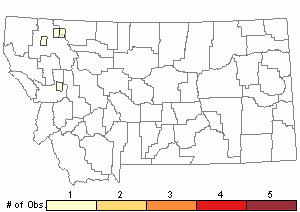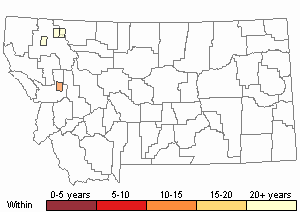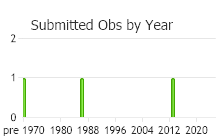View in other NatureServe Network Field Guides
NatureServe
Montana
Utah
Wyoming
Idaho
Wisconsin
British Columbia
South Carolina
Yukon
California
New York
Blunt Water Moss - Pseudocalliergon trifarium
Other Names:
Worm Moss,
Calliergon trifarium
General Description
Plant: Tufts or loose mats. Yellow-green above, browning below; not golden-gloss when dry. Stems 4-14 mm long and 1-2 mm wide, slightly turgid, primarily straight and unbranched.
Leaf: Usually imbricate. Stem leaf 1-2 x 1-1.6 mm. Concave, smooth, and broadly ovate with a broadly rounded apex. Margin entire. Costa single, extending ½ - ¾ the length of leaf.
Leaf Cells: Distal lamina cells smooth. Alar cells long rectangular, thick-walled, and inflated, often forming a triangular region.
Stems are often divided into segments that correspond to the growing season. In the spring segment the leaves are small and more imbricate.
Diagnostic Characteristics
Pseudocalliergon species are similar to Drepanocladus species. P. trifarium could be confused with Loeskypnum wickesiae, but generally grows in habitats more rich with minerals. It also has more broadly ovate leaves than L. wickesiae and a broadly rounded apex rather than an apiculus, and has no rhizoid initials in the leaves (FNA 2014).
Range Comments
Greenland; Canada: AB, BC, NL, NT, NU, ON; USA: AK, CT, MI, MN, MT, NY, OH, OR; West Indies (Dominican Republic); South America (Colombia, Venezuela); Eurasia (FNA 2014). It is widespread in northern and central Europe (Crum 1981), and is found in most provinces of Fennoscandia (Nyholm 1954-69). In Montana: Flathead, Glacier, and Missoula Counties (Elliott 2016).
Observations in Montana Natural Heritage Program Database
Number of Observations: 4
(Click on the following maps and charts to see full sized version)
Map Help and Descriptions
Relative Density

Recency



 (Observations spanning multiple months or years are excluded from time charts)
(Observations spanning multiple months or years are excluded from time charts)
Habitat
Substrate: Wetland soil, occasionally soils on rock. Habitat: Lime-rich fens and usually deep fens, sometimes in rocky soil with trickling water or spray zones of waterfalls. Often found as single shoots amongst other species, especially Scorpidium. Low to high elevations.
Reproductive Characteristics
Dioicous. Capsule horizontal to inclined.
Stewardship Responsibility
References
- Literature Cited AboveLegend:
 View Online Publication
View Online Publication Crum, H.A. and L.E. Anderson. 1981. Mosses of Eastern North America. 2 volumes. Columbia University Press, New York. 1328 pp.
Crum, H.A. and L.E. Anderson. 1981. Mosses of Eastern North America. 2 volumes. Columbia University Press, New York. 1328 pp. Elliott, J.C. and A.K. Pipp. 2018. A Checklist of Montana Mosses (1880-2018). Updated 3 January, 2020. Montana Natural Heritage Program, Helena, Montana. 73 pp.
Elliott, J.C. and A.K. Pipp. 2018. A Checklist of Montana Mosses (1880-2018). Updated 3 January, 2020. Montana Natural Heritage Program, Helena, Montana. 73 pp. Flora of North America Editorial Committee, eds. 2014. Flora of North America North of Mexico. Volume 28. Bryophytes: Mosses, Part 2. Oxford University Press, Inc., NY. xxi + 702 pp.
Flora of North America Editorial Committee, eds. 2014. Flora of North America North of Mexico. Volume 28. Bryophytes: Mosses, Part 2. Oxford University Press, Inc., NY. xxi + 702 pp. Nyholm, E. 1954-69. Illustrated Moss Flora of Fennoscandia. II. Musci. Fascicles1- 4. Gleerups, Lund; Fascicles 5-6, Swedish Natural Science Research Council, Stockholm.
Nyholm, E. 1954-69. Illustrated Moss Flora of Fennoscandia. II. Musci. Fascicles1- 4. Gleerups, Lund; Fascicles 5-6, Swedish Natural Science Research Council, Stockholm.
- Additional ReferencesLegend:
 View Online Publication
View Online Publication
Do you know of a citation we're missing? Elliot, J. C. 1993. Second checklist of Montana mosses. Unpublished report. U.S. Forest Service, Region 1. Missoula, MT. 45 pp.
Elliot, J. C. 1993. Second checklist of Montana mosses. Unpublished report. U.S. Forest Service, Region 1. Missoula, MT. 45 pp. Lawton, E. 1971. Keys for the Identification of the Mosses on the Pacific Northwest. Reprinted from 'Moss Flora of the Pacific Northwest'. Published as Supplement No. 2 of the Journal of the Hattori Botanical Laboratory. Nichinan, Miyazaki, Japan. 66 pp.
Lawton, E. 1971. Keys for the Identification of the Mosses on the Pacific Northwest. Reprinted from 'Moss Flora of the Pacific Northwest'. Published as Supplement No. 2 of the Journal of the Hattori Botanical Laboratory. Nichinan, Miyazaki, Japan. 66 pp. Lawton, E. 1971. Moss Flora of the Pacific Northwest. Hattori Botanical Laboratory. Japan: Yamabuki-cho, Shinjuku-ku, Tokyo. 362 pages plus appendices.
Lawton, E. 1971. Moss Flora of the Pacific Northwest. Hattori Botanical Laboratory. Japan: Yamabuki-cho, Shinjuku-ku, Tokyo. 362 pages plus appendices.
- Web Search Engines for Articles on "Blunt Water Moss"





